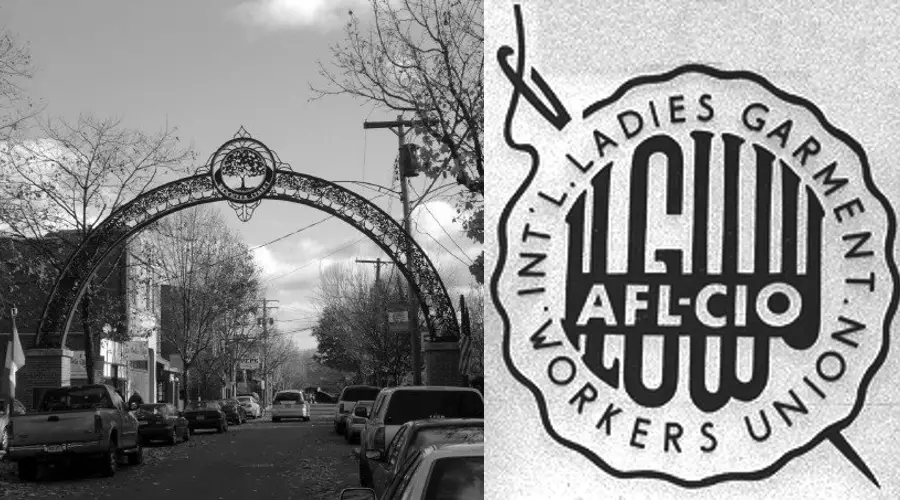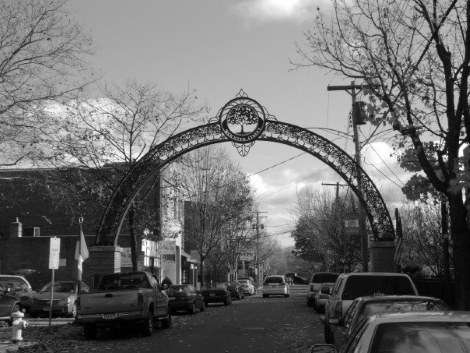In 1933, a poor Italian-American teenager led the dramatic New Haven garment workers strike that lifted thousands of women into the middle class.
Jennie Aiello wasn’t the only leader of the New Haven garment workers strike of 1933. But she was certainly a key to its success.
On a cold day in April, Jennie slid down the clothing chute from the second-floor cutting room of the huge Lesnow Brothers shirt factory to rally the stitchers on the first floor to strike.
The month-long Lesnow Brothers strike that followed climaxed a series of successful job actions during 1933.
The wave of strikes resulted from cooperation between two labor unions, the International Ladies Garment Workers Union and the Amalgamated Clothing Workers of America. From 1933 on, the unions’ two New Haven locals were central to their members’ political and social lives until the garment industry’s demise in the early 1990s.
New Haven
New Haven by 1933 had a long and storied labor history. In 1884, women shoemakers struck the L. Candee Rubber Boot Company. In 1886, strikes engulfed the city at 29 businesses. That year, The New York Times reported, “This town has picked up the reputation lately of having more strikes than an (sic) other city of its size in the country.”
New York City was the center of the garment industry, but in the 1920s so-called “runaways” moved to Connecticut, New Jersey and Pennsylvania so they could pay workers less. New Haven attracted clothing manufacturers because of its cheap factory space. The city also had a large pool of poor African Americans and Polish and Italian immigrants. Employers could get away with paying low wages because hardware and weapons makers had floundered after World War I.
The Great Depression
By 1933, workers grew increasingly desperate as the Depression sent mainstay employers reeling. Sargent Brothers Manufacturing laid off workers and L. Candee Rubber Co. went under. In 1931, the Winchester Repeating Arms Company went into receivership.
Jennie Aiello’s family suffered through the hard times. Her parents had emigrated from Italy and periodically relied on relief to support their seven sons and seven daughters. Jennie’s older brothers got work through the Works Progress Administration, the Civilian Conservation Corps and the garment factories.
Jennie and her six sisters quit school at 13 or 14 to work in the Wooster Square shirt shops. Only the youngest sibling, Nick, would graduate from high school.
Thousands of men and women then worked in New Haven’s needle trades centered on Wooster Square. During the early years of the Depression, New Haven led the state in the number of work certificates issued to young women, 20 percent of whom were under the age of 16.
Sweat Shop
Jennie Aiello and her sister Lucy went to work for Lesnow Brothers, the largest garment employer in Connecticut. The company employed 550 mostly very young women in the heart of New Haven’s garment district.
It was a sweat shop: dangerous, unsanitary, unventilated and unheated.
Wages were low and hours were long. Spreaders in the cutting rooms, where Jennie worked, earned $4.50 for a 54-hour week ($80.63 in today’s equivalent). Cuff turners earned $4 for a 60-hour week (today’s equivalent of $71.68). The work was seasonal and employees had to take long layoffs.
One worker remembered Harry Lesnow as “cruel, very ugly.” He’d come around the shop floor and yell “Get the hell!” if a worker went to get a drink of water.
Jennie was one of the eight or 10 girls at Lesnow Brothers who led the drive to form a union. They would quietly ask workers to join them outside the building to talk. They met secretly in Waterside Park on Saturdays.
Before the Strike
A great deal of preparation preceded the New Haven garment workers strike.
Sidney Hillman, president of the Amalgamated Clothing Workers of America (ACWA), had begun a campaign in 1932 to organize the runaway clothing manufacturers in neighboring states. He sent his wife Bessie to help organize New Haven, where she had family ties. Young Italian women came from nearby cities to help organize.
By 1933, the ACWA and the ILGWU had already organized four small contract shirtmakers in New Haven.
But the Lesnow workers faced daunting obstacles in their union drive. Even talking about a union cost workers their jobs. Parents feared letting their daughters strike because they so desperately needed their meager income.
Italian-speaking union officials went to the parents’ homes to persuade them to support the action.
Lena Riccio was a 15-year-old who earned a few dollars a week at Lesnow Brothers and handed over her entire pay envelope to the family.
“We were afraid,” she said. “You didn’t know who to listen to.”
The male organizers’ high pressure tactics frightened her, while the boss threatened to fire them. Some of the girls pretended to go to meetings to talk about the union, but instead hid out in a candy store, she said.
One organizer, Jennie Formichelli from Bridgeport, talked nicely to the girls. After weeks of indecision, Lena finally decided to join the union effort.
New Haven Garment Workers Strike
The Lesnow Brothers provoked the New Haven garment workers strike at the beginning of April. The company demanded additional piecework from the workers without paying them more.
Jennie Aiello was working on the second floor as a cutter when she decided to walk off the job. Workers who sided with the company tried to block her. She dodged them, sliding down the chute with bales of unfinished shirts. She then rallied her friends on the first-floor stitchery to join her.
That began a month of police intimidation while picketing in the cold. If any strikers marched out of the line, the police hit them with billy clubs. They targeted the male leaders, but didn’t spare the women.
The anti-union New Haven Register barely covered the New Haven garment workers’ strike. The school district wouldn’t allow strikers to meet in the school auditoriums. They couldn’t get permits to assemble in a park for a rally. Male workers and some of the women stayed on the job.
Jennie Aiello walked the line along with the union organizers and other workers during that cold spring. The Saint Trofemina and Saint Andrew social clubs let them come in and get warm, drink coffee and eat a sandwich before going back out on the line.
Momentum
The strikers held together, and momentum began to turn in their favor. On April 18, the ACWA called for a nationwide strike of unorganized shirtmakers. By Monday, April 24, striking workers closed nearly all of the New Haven shirt companies.
The Connecticut State Board of Education sided with the strikers, notifying the labor commissioner that school-age children were working in factories. A letter from the school board described a “little girl” working for the LeRoy Shirt Company who earned 37 cents for working 24 hours.
The most dramatic confrontation of the strike probably happened on May 1, when Yale Divinity students joined the striking Lesnow workers on the picket line. Strikers from other shirt companies swelled their ranks.
That day, the height of the New Haven garment workers strike, Lesnow’s male employees decided to join the revolt and walked off the floor. Lesnow Brothers then had to shut its doors.
By May 3, Lesnow’s signed a contract with Sidney Hillman and Jacob Potofsky, another ACWA official. The workers got a 10 percent wage increase, health insurance and a pension. A year later, a new garment industry code shortened their days to 35 hours a week in the dress industry and 40 hours in the shirtmaking business.
Within six weeks of the Lesnow strike, virtually all of New Haven’s shirt companies were union.
Later that year, the ILGWU called for a general strike. According to the Greater New Haven Labor History Archives, there were strikes in all of the city’s dress shops. After two weeks of rallies, pickets and a shutdown of the industry in New Haven, the ILGWU represented all the dressmaking workers in the city.
What Happened Next
Jennie Aiello got married. Her younger brother Nick became the business agent for ACWA Local 151, a pillar of the Connecticut labor movement. He spearheaded the Greater New Haven Labor History Project, which included the story of the New Haven garment workers strike.
In 1939, Lesnow’s moved to Easthampton, Mass.
During the 1970s and ’80s, garment makers ran away to the South. Later, they moved to the Pacific Rim and South Asia for extremely low wages and dangerous working conditions. In 2013, more than 1,000 factory workers were killed in Bangladesh when their building collapsed.
The ACWA merged with the Textile Workers Union of America, which then merged to form UNITE, which since merged with the hotel workers’ union to become UNITE HERE.
With thanks to “Learning To Forget Schooling and Life in New Haven’s Working Class,” by Stephen Lassonde, Karen Pastorello in The Power Among Them and Anthony Riccio’s The Italian American Experience in New Haven.. This story about the New Haven garment workers strike was updated in 2022. Image of ILGWU label By Source (WP:NFCC#4), Fair use, https://en.wikipedia.org/w/index.php?curid=41361646.



6 comments
Great story! One thing: ILGWU merged with ACTWU, which had been created from an earlier merger between ACWA and the Textile Workers Union of America (TWUA). The latter organized the big JP Stevens boycott in the 70s. (I was an organizer or the ILGWU). Hard to keep it straight without a scorecard!
“The park district wouldn’t give them permits to assemble for a rally.”
That is an odd turn of phrase for someone who is familiar with New England — and reinforces the impression this piece was primarily written as a bit of union history from someone outside of and uninterested in the area, and New England history only by accident of location.
We don’t have park systems independent of the city or state here, with a few exceptions — such as those operated by the Metropolitan District Commissions of Hartford (today, around their reservoirs) and Boston (since merged with the state parks) or Providence Metropolitan Parks Commission (long since devolved into city and state parks) — and those which exist are not referred to as “districts” as they lacked political independence to elect their own leadership and the financial independence of being able to directly levy taxes. “Park District” is a very Chicago-ish way to refer to city parks, as there they do have extensive park systems that exist as independent districts with taxing authority similar to fire districts here.
“School district” in the previous line isn’t as unusual, but still seldom heard outside of state-level educational wonks who use it to encompass both regional school districts and the more common town-operated school systems, and to some extent to encompass the older, early 19th centruy heritage of once independent school districts within towns.
[…] With World War I and the Russian Revolution exploding in that spring, the orders kept coming in for more rifles, saddles, armored cars, ammunition and small arms. Remington Arms couldn’t find enough workers. Finally, management decided to hire the women of Bridgeport, then employed in department stores and garment factories. […]
[…] when middle-class Americans feared the country was being overrun with immigrants, radicals and labor unions. Coolidge's moralistic response — "There is no right to strike against the public safety by […]
[…] easy. Italian men ended up working low-paying construction jobs, while women usually worked as seamstresses in garment factories. Many Italian immigrants led the fight for better pay and working conditions. Arturo Giovanitti, […]
[…] year, fur workers went on strike in Danbury, textile workers walked out in Putnam and New London, garment workers walked off the job in New Haven and laborers struck in […]
Comments are closed.